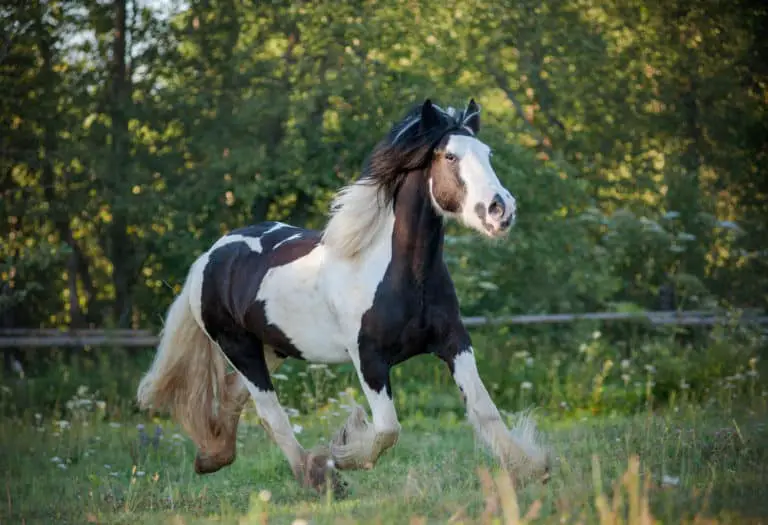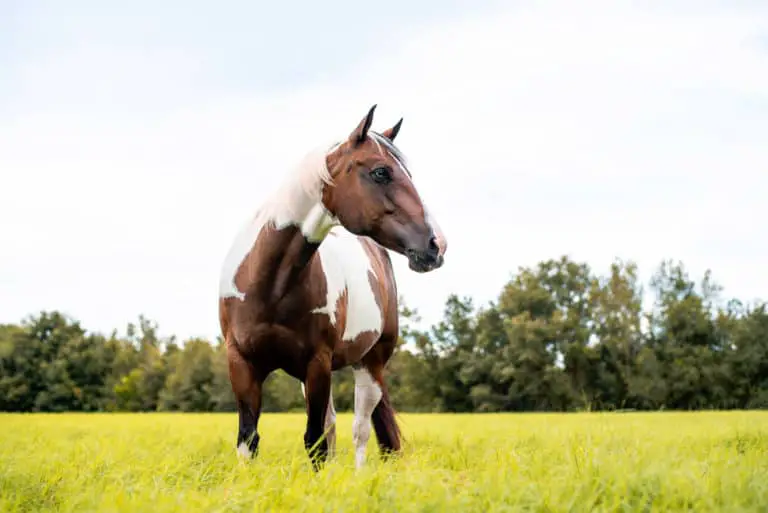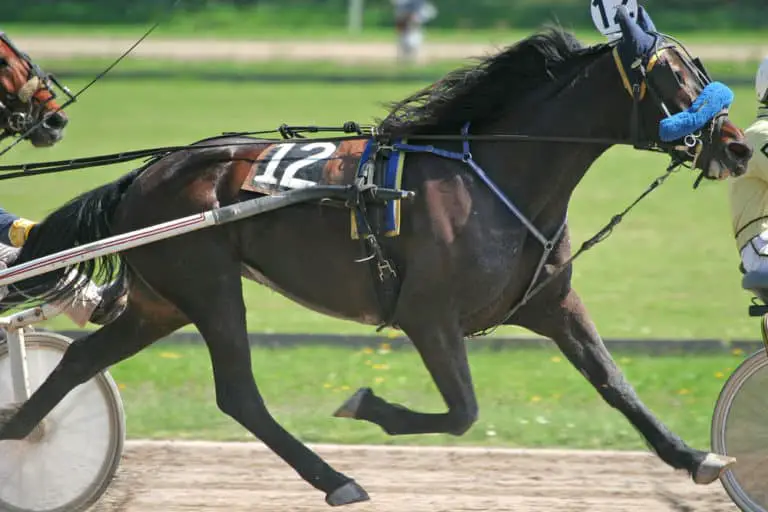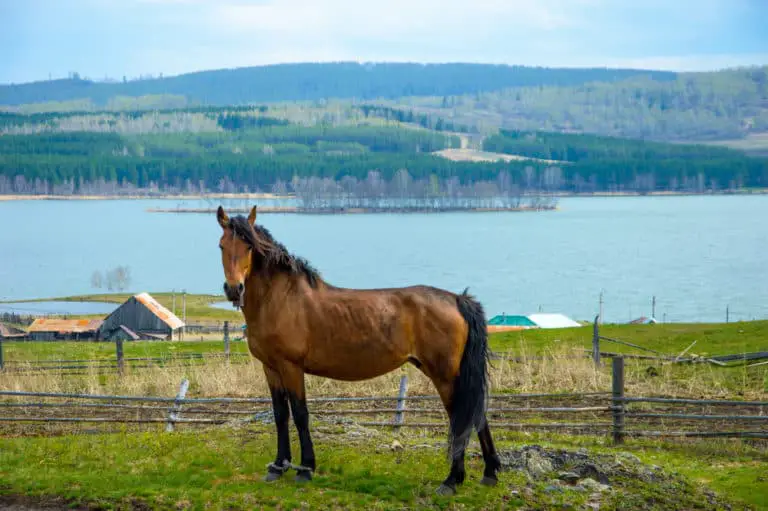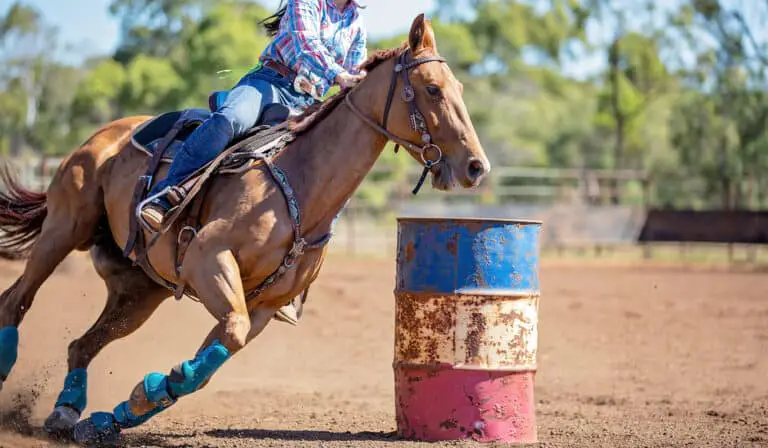Dutch Draft Horse: Care, Cost & History (2024)
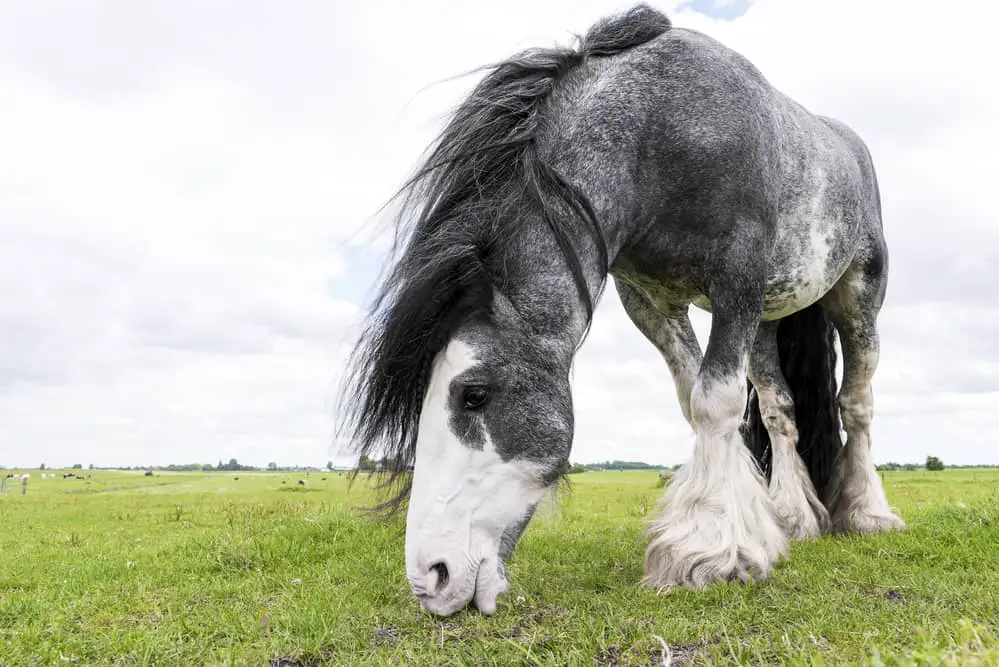
People in the Netherlands developed the Dutch Draft horse for heavy agricultural work after the first world war. The breed had its heyday between the two wars when it was used extensively on the farms and in the forests. Although it’s not as widely used today, these calm draft horses are known for their strength and stamina.
Breed: Dutch Draft horse
Adult Weight: 1,650-2,200 pounds
Adult Height: 15.3-17.1 hands (63-69 inches)
Origin: Netherlands
Use: Draft horses, riding, pleasure
Colors: Chestnut, black, brown, and roan
Features: Short and heavily muscled
Lifespan: 25-30 years
Character: Calm, sensitive, good stamina, and stubborn
Gait: Tactful and sure-footed
Best for: Intermediate to experienced riders
- Characteristics
- Dutch Draft Care
- Dutch Draft History
- Modern Dutch Drafts
- Cost and Ownership
- Buying a Dutch Draft
- Similar Breeds
Dutch Draft Horse Characteristics
The Dutch Draft horse characteristics harken to those of the Belgian, a breed that helped create it. The Dutch Draft horse head is somewhat coarse, but with a large, kind eye. The neck and back are both short. Their shoulder is long and sloping into a broad chest. The legs are strong with feathering around their large hooves.
Size
Dutch Draft size is considered short among some of the draft breeds. The breed standard states that horses are between 15.3 and 17.1 hands (or 63 to 69 inches tall at their withers). (1) Most people commonly agree that Dutch Draft horse height averages 16 hands though. (2)
Male horses tend to be slightly larger than female horses. Non-adult horses are proportionate to the adults and usually have reached most of their adult height by four years of age, and are full-grown between ages five and six.
Although Dutch Draft horses are not the tallest draft breed, it doesn’t limit their strength or stamina, two characteristics the breed is known for.
Weight
The Dutch Draft horse weight is between 1,650 and 2,200 pounds, which, with their height, makes them appear shorter and heavier than other draft horse breeds. This heavier weight is supported by large, solid bones with the structure to support the extra weight.
Again, the males tend to weigh slightly more than the females. A Dutch Draft foal will weigh about 10% of what its mother weighs, so most foals are between 160 and 200 pounds at birth. By the time the foal is six months old, they are almost 50% of their adult weight.
The heavier weight of the Dutch Draft breed made it popular for agricultural work because it gave them their strength and stamina.
Colors
The primary Dutch Draft horse colors are chestnut, black, brown, and variations of roan. The roan horses are all white hairs interspersed with either the chestnut, black, or brown coat colors.
Gray is not common, and along with black are the rare Dutch Draft horse colors. The roans, chestnuts, and browns are more common because of the influence of the Belgian Draft horse breed in developing the Dutch Draft.
Sometimes a beautiful Dutch Draft horse is referred to as a blue mould color, but this means roan. This is a horse with a black coat color with the interspersed white hairs, and it’s also a rarer color.
Temperament
Dutch Draft horse temperament is similar to other cold-blooded horses in that they are calm and even-tempered. A hallmark of Dutch Draft horse behavior is that they are very quiet and have slow, steady movements. This is one of the characteristics that made them most valuable as agricultural workhorses.
The Dutch horse can also be sensitive and are known to be stubborn and grumpy if they don’t feel they’re being treated fairly. However, if the person working with them is sensitive and caring, the horses are willing workers.
The Dutch Draft breed follows the general rules of the United States Equestrian Federation, which states that children are not allowed to exhibit stallions. (3)
Dutch Draft Horse Care
The Dutch Draft horse breed is easy to care for and requires little maintenance or special attention beyond the routine care horses normally receive. Horses require shelter, veterinary care, exercise, and a diet that isn’t too rich, as they maintain their weight easily. The Dutch Draft horse lifespan is between 25 and 30 years.
Diet and Nutrition
Draft horses require more feed than smaller-sized horses. Being an “easy keeper” means that the Dutch Draft diet should actually be less than the normal energy recommendations for a draft horse if they aren’t working, and the level of work increases their diet requirements. (4)
Water is the most important nutrient for horses. Next is roughage, and this is usually foraging in the form of pasture and hay. Draft horses tend to be healthier if their forage consists more of hay than grass.
The nutritional content of the hay varies depending on when it was harvested and the soil type where it was grown. Finally, some grain or nutritional supplementation may be needed, but grain should be minimal. (5)
Health Problems
Unfortunately, no species is immune from health problems, including the Dutch Draft horse. They have a few issues that will cause issues, and owners should be aware of these and take preventative steps where possible.
One of the most common genetic problems is Type 1 Polysaccharide Storage Myopathy (PSSM). This causes horses to have an inability to store glycogen, also known as sugar, in their muscles. The effect is horses tighten up and are unable to move in the worst case.
Preventative measures are a strict diet, preventing the horse from becoming overweight, and exercise. Consult a veterinarian and equine nutrition specialist for specific guidance. (6)
Grooming
There are a lot of good reasons to groom horses – it helps an owner bond with the horse, provides mental stimulation for the horse, and keeps them clean and presentable. But, there are health reasons for Dutch Draft grooming too.
Dirt and debris that accumulates on the horse’s coat can become a place where bacteria congregate and then multiply, causing health issues for the horse. Regular grooming removes the dirt and debris and prevents these bacterial buildups.
It’s also a great time to check for any cuts, scrapes, or other issues. Hooves should also be cleaned daily and checked for bruising or odor that could be symptoms of larger issues. (7)
Dutch Draft Horse History
Dutch Draft horse history is young – the breed developed in the 1900s, in between the world wars. The native Zeeland horse of the Netherlands was crossed with the Belgian to create a massive horse that could pull carriages, wagons, and work in agricultural fields. Mechanization after World War II threatened their population, but numbers have steadily stabilized.
Origin
The Dutch Draft horse origin ties to the need for a heavy draft horse in the Zeeland and North Brabant provinces in the Netherlands. They used the Belgian draft horse and Belgian Ardennes to cross with their local horses, creating the breed after World War I. Their ancestors are the workhorses of the Middle Ages.
The horses were bred to work in the marine clay of the Groningen province and on the arable farmland in the area. The people needed heavy horses that could withstand a full day of hard work.
The Dutch had two other breeds of horses they developed but wanted the Dutch Draft specifically for the heavy and prolonged work.
Historic Development
Breeding focused on the three provinces where the Dutch Draft was most frequently used – Zeeland, North Brabant, and Groningen. The horses were also used in South Holland and the surrounding provinces as tug horses and were the most important breed for the Dutch people.
Mechanization after World War II limited the need for draft animals, and breed population numbers declined.
The Nederlands Trekpaard, as the Dutch call the horse, was preserved by a dedicated group of breeders because it’s tied so closely to the longtime traditions of ring riding and the annual beach ride that welcomes spring to the region. Of course, these breeders also still have other uses for the horses.
Notable Dutch Draft Horses
There are many famous Dutch Draft horses, although we rarely use their names. They are seen in iconic photos of the Holland landscape or as model horses in the playrooms of children. However, Maarten showcases his Dutch Draft horse pedigree and the reasons people love the breed in a brief yet memorable video.
Maarten
Maarten is a Dutch Draft gelding seen cantering down a wooded trail with his rider, toward the camera in a YouTube video with over 2.8 million views. Koudbloed Kim, his rider, trots him into view to upbeat music before picking up the canter and coming towards the camera. He’s a traditional-looking Dutch Draft with a white star.
Zeeuws Horses
Zeeuws is the Dutch word for Zeeland, and many photographers visit the area. Their photos are found on Shutterstock and other sites, and the horses are collectively known as the Zeeuws horses. Iconic images feature the windmills in Holland in the background or the horses with their mane braided traditionally standing on a beach.
The Breyer Model
Breyer horse models have been delighting equestrians and non-equestrians for generations, and the Dutch Draft Mare Roan is a popular model. She is a blue roan that exemplifies the breed characteristics. The model is popular with collectors and is out of stock, with plans in place to produce more in late 2022.
Myths and Legends
Dutch Draft horse legends include stories of their amazing strength and stamina, beauty, and fancy footfalls. The horses are thought of so synonymously as a breed, as we saw with our famous horses, that the myths and legends about the breed align with them as a whole. They are legendary for their elegant gaits, surprising speed, and distinct bloodlines.
Fancy Trotters
The Dutch enjoy a fancy horse with a good turn of the hoof. This is one of the traits they didn’t sacrifice in developing the Dutch Draft horse. These horses are known for an elegant and fancy trot, despite their massive size. They are beautiful to watch in harness or under saddle as Maarten demonstrates.
Slow and Steady
The unhurried gaits of the Dutch Draft are one of the reasons people used the breed extensively for agricultural work. But, a Dutch Draft horse can run up to 20 miles per hour, which is especially evident during their annual beach ride or at other events where the horses have wide open space and a lighter load.
The Same as a Belgian
The Dutch Draft and Belgian breeds are sometimes thought of as interchangeable. Although the Belgian was crucial in developing the Dutch Draft breed, they are now separate breeds of horses with distinct bloodlines. In fact, there are two organizations stewarding Dutch Draft pedigrees, including the Royal Society of the Dutch Draft Horse formed in 1914.
Modern Dutch Draft Horses
The last 50 years have been a renaissance era for the breed and the types of Dutch Draft horses we see demonstrate this. They are beloved as leisure horses in riding and driving. Their manes are beautifully braided with ribbons as they are shown off for their size and power and enjoyed by their owners.
Breeding
Most Dutch Draft breeding occurs in the Netherlands, and the breed is not widely available outside its home country. Some horses have been exported and select individuals are available in other locations.
In the Netherlands, the two breed organizations carefully track and promote Dutch Draft horse breeding to ensure that they continue to thrive and the bloodlines are preserved. A Dutch Draft stallion must pass DNA and other tests before being approved and standing at stud.
Horses are bred primarily for leisure uses and their ties to Dutch culture. Some are still used in farming occupations in areas where tractors and modern equipment struggle.
Population
The Dutch Draft horse population is endangered but has stabilized with 3,000 mares listed in the Netherlands. (8) Stallions, geldings, and young stock increase this number slightly, however, the mare numbers are crucial to the future of the breed.
Most of the population is in the Netherlands because this is where the breed originated. Horses that are exported were in small numbers and are generally in small populations, meaning they are unlikely to increase in numbers.
You can find Dutch Draft horses in other European countries. The few in the United States were imported by draft horse enthusiasts and are a rare find for equine shoppers.
Uses
The Stichting het Werkend Trekpaard Zeeland was formed to promote Dutch Draft horse uses throughout the country. It’s a dedicated group of 15 owners and breeders that promote traditional uses of the breed from their heyday in the 1930s.
They have Instagram-worthy photography and media that includes harvest days with beautifully groomed horses, traditional equipment, and handlers in outfits from the 1930s.
Horses are also used for riding, as Maarten so finely demonstrates. The breed makes a prominent appearance at the annual Strao Festival and the beach ride as well. The Dutch Draft horse gait with the snapping knees at the trot ensures that they are noticed whenever present.
Dutch Draft Horse Prices
Owning a horse can be an expensive but rewarding process. Many people associate the initial purchase price with horse ownership but forget about budgeting for annual upkeep. The Dutch Draft horse price includes the purchase price and things like board or where the horse lives, their feed, and veterinarian costs.
Purchase Price
Different breeds of horses have different purchase prices, some are more expensive and others are less expensive. Factors that influence the purchase price of a horse include the horse’s age, gender, level of training, availability of the breed, and special features, like color.
The price of Dutch Draft horse is between $4,000 and $7,000 and this is usually the price for an adult horse. (9) Expect to pay more for a mare and one with Dutch Draft horse training, especially if a horse can be ridden and driven. The breed is somewhat expensive because there aren’t as many available horses.
Ownership Costs
With Dutch Draft price, the purchase comes first, and then horse ownership costs. These include board, the food a horse eats, veterinary care, and hoof care. All of these are necessary for the health and well-being of the horse. Expect to pay $1,770 to $12,930 each year for Dutch Draft horse cost of ownership.
Board
Board is the horse’s mortgage or rent – it pays for their stall or shelter and a pasture for exercise. It’s a basic standard of care for all horses and is usually paid monthly. Expect to pay between $1,200 and $7,200 a year for Dutch Draft horse board costs, depending on the type of facility. (10)
Feed
Dutch Draft horse feed cost is their grocery bill and is between $250 and $4,380 annually. (10) Horses with pasture are in the lower price range, and areas without good access to pasture and hay will be on the higher end. Of course, drafts eat more than say a miniature horse, so that influences the total cost too.
Veterinary Care
It’s just as important for a horse to see their veterinarian for preventative care as it is for us to see our doctors. Dutch Draft horse veterinary cost is about $250 to $350 each year and includes vaccinations, deworming, and dental care. (10) Sickness and injuries are additional costs that will increase this total.
Hoof Care
Hooves are like fingernails, they grow non-stop and need maintenance every six to eight weeks. Some horses also require shoes, especially if they’re in heavy work. Dutch Draft horse hoof care cost is $120 to $1,000 annually, with horses needing shoes costing the most. The farrier performing the hoof care will recommend shoes if needed.
Buying a Dutch Draft Horse
Drafts are gentle giants, and the Dutch Draft breed meets this definition. However, you should still meet the horse before you buy it, because each one is an individual, just like us. It’s also helpful if you know if you can work with the sensitive nature of these horses so you don’t make your horse act stubborn and grumpy.
Is the Dutch Draft Horse Right for You?
When I think about riding a Dutch Draft horse, I think of the beach rides at the annual festival and the fun that Maarten’s rider had cantering down the lane. Those are dreams that many of us have in horse ownership, and owning a Dutch Draft can make those dreams a reality.
These are awesome horses that are sturdy, sure-footed, calm, and fun. But they are also sensitive. Take some riding lessons and understand horses before you buy one, it will make your relationship with the horse that much stronger. Driving is also fun, and Dutch Drafts are naturals, if you haven’t learned yet, a few lessons will help get you started.
How to Buy a Dutch Draft Horse?
Buying a Dutch Draft horse can be difficult because the population is limited. First, identify why you want to buy a horse and what you want to do with them. Then, find a Dutch Draft breeder that can tell you more about the horses available, bloodlines, and key characteristics that make them such a special breed.
Once you’ve identified a few horses, go and meet them and see if you can ride or drive them. Ask questions about the horse’s history and avoid those that seem to have an overly grumpy or unwilling temperament. Look for a horse that you feel comfortable with and that can help you fulfill your goals.
Similar Breeds to Dutch Draft
If you are struggling to find the perfect horse, you might consider Dutch Draft breed alternatives. The Belgian Draft horse has a larger population with the same strength and easygoing temperament. The Haflinger horse isn’t technically a draft but is common throughout Europe and the United States. The Ardennes Horse is also an endangered draft breed from Europe.
Belgian Draft Horse
The Belgian Draft horse is a French breed that is known for its strength and distinctive strawberry blonde coat color. They have a similar calm temperament to the Dutch Draft horse, although are generally more cheerful. Belgian Draft horses also have a larger breed population and are found throughout the world, especially in the United States.
Haflinger Horse
The Haflinger horse breed developed in Austria and is a popular breed in the Netherlands. They are smaller than Dutch Draft horses but are also very strong. They are known for their blonde color and flaxen mane and tail, as well as versatility in harness or under saddle. They’re technically not draft horses.
Ardennes Horse
The Ardennes Horse is one of the oldest draft breeds and like the Dutch Draft Horse, is a shorter, heavy horse. They also originated in Europe and are an endangered breed still used for draft work and some leisure. The Ardennes have friendly temperaments and enjoy working. The two primary colors are bay and roan.
FAQ
What is a Dutch Draft horse?
A Dutch Draft horse is a breed of horse that originated for draft and agricultural work in the Netherlands, where it is still used today.
What does a Dutch Draft horse look like?
Dutch Draft horses are coarse, strong horses that are short and heavily muscled. They are usually chestnut, black, brown, or roan.
How did the Dutch Draft horse get its name?
The Dutch Draft horse is named after its homeland, the Netherlands.
Can you ride a Dutch Draft horse?
Yes, Dutch Draft horses can be ridden. They are also used in agricultural work and as driving horses.
Are Dutch Draft horses good for beginners?
Dutch Draft horses are not good for beginners; they are calm but also stubborn. They are best for intermediate or experienced equestrians.
How tall is a Dutch Draft horse?
A Dutch Draft horse is 15.3 to 17.1 hands or 63 to 69 inches tall.
How much does a Dutch Draft horse weigh?
Dutch Draft horses weigh between 1,650 and 2,200 pounds.
How big is a Dutch Draft horse?
Dutch Draft horses are larger than regular horse breeds, although not the tallest of draft horses. They’re considered short but heavily muscled.
How much does a Dutch Draft horse cost?
Dutch Draft horses cost between $4,000 and $7,000, although some are more expensive because the breed is endangered.
How much does a Dutch Draft horse ownership cost?
Dutch Draft horse ownership costs between $1,770 to $12,930 annually.
How long do Dutch Draft horses live?
Dutch Draft horses live 25 to 30 years.
How fast can a Dutch Draft horse run?
A Dutch Draft horse can run about 20 miles per hour.
How much can a Dutch Draft horse pull?
A Dutch Draft horse can pull between 2,475 and 3,300 pounds.
How much can a Dutch Draft horse carry?
A Dutch Draft horse can carry between 330 and 440 pounds.
At what age is a Dutch Draft horse full grown?
Dutch Draft horses are usually full-grown between the ages of five and six years old.
What are Dutch Draft horses used for?
Dutch Draft horses are used for agricultural work, forestry, and pleasure riding and driving.
References
- The Dutch Draft Horse and The Haflinger. 2022. Regulations and Documents. Link
- Rare Pet Breeds Foundation. 2022. Dutch draft horse. Link
- United States Equestrian Federation. 2022. Licensed Competitions. Link
- Dept. of Animal Nutrition Co. V. Sc. & AH Jabalpur (M.P.). 2022. Feeding of Horses. Link
- Merck Vet Manual. 2021. Nutritional Requirements of Horses and Other Equids. Link
- Michigan State University, College of Veterinary Medicine. 2022. Type 1 Polysaccharide Storage Myopathy. Link
- Merck Vet Manual. 2021. Routine Health Care of Horses. Link
- Rare Pet Breeds Foundation. 2022. Dutch draft horse. Link
- Rare Pet Breeds Foundation. 2019. Stallion Inspection Result. Link
- Arabian Horse Association. 2022. What is the Cost of Providing for Them? Link

